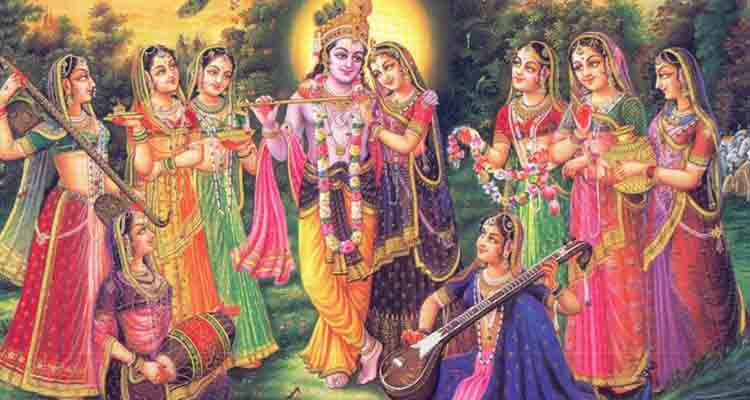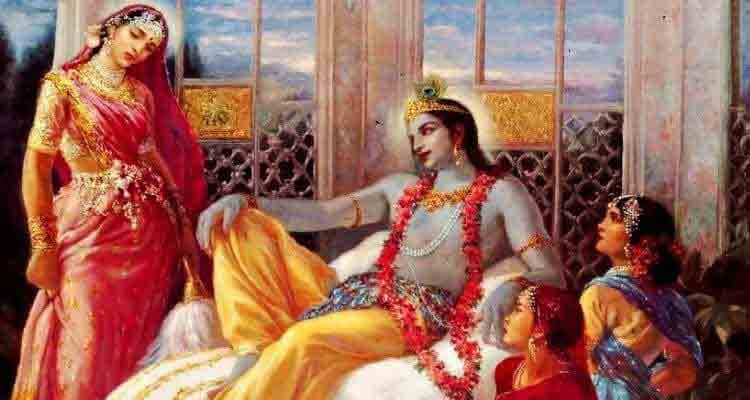How Many Wives Does Krishna Have?
Even though Satyabhama and Rukmini are the only two names that instinctively come to mind when one thinks of Lord Krishna’s wives, the actual number stands at 16,1008. That number can seem astounding, especially to those who don’t the real story behind. Asur king, Naraka, born to an incarnation of Lord Vishnu, Varaha, and goddess Earth, Bhudevi, ruled over Pragjyotishpur. Being a powerful demon, he wanted to take control of heaven and earth. He captured all of the kingdoms (Dwarka was not a kingdom) on earth as well as the Swarga Loka. In the process, he took 16,100 queens as captives after defeating their husbands. Distressed by these events, Aditi reached out to Satyabhama to look to get rid of Naraka. Satyabhama, then, sought Lord Krishna’s help to wage a war against the demon king. The two attacked Pragjyotishpur. Krishna killed Naraka’s general Mura in the battle because of which he is also known as Murari – the destroyer of Mura. Satyabhama, who was an incarnation of Bhudevi, shot the fatal arrow that killed Naraka. Having eliminated the demon king, Krishna and Satyabhama set out to release the 16,100 captive women. These women were so mesmerised by Krishna’s divine aura that they declared that they’d kill themselves if the lord didn’t marry them. He shared marital bliss with eight of his primary wives, of which two – Satyabhama and Rukmini – held a special place in his life and palace.
The Parijat Tree Story
The Parijat tree which bears lovely white flowers with an orange stem was planted in the abode of Lord Indra. This tree was part of the gifts received during the Samudra Manthan, or the churning of the ocean, and was a celestial plant, not found on earth. When Krishna’s wives Satyabhama and Rukmini each expressed a desire to have the tree exclusively to herself, the Lord set an example of the perfect balancing act. Thus, the Parijat tree story became a symbol of how Krishna divided his love equally among his wives.
Narada, the mischief-making sage, sows seeds of discord
Once Narada got a few of the flowers from the Parijat tree and gave them to Lord Krishna, wondering which of his wives would he give the flowers to, Rukmini or Satyabhama. Krishna gave the flowers to Rukmini. On seeing this, Narada went to Satyabhama and told her about it. Seeing Satyabhama all riled up with jealousy, Narada went on to suggest a solution to her – that she should not settle for just a few flowers rather insist that Krishna get her the tree from Indralok and plant it in her garden so that she could have for a regular supply of these exotic flowers! When Krishna visited Satyabhama’s quarters, she expressed her anger and disappointment at the whole incident and insisted that she would settle for nothing less than the plant itself! Narada, meanwhile, went and warned Indra that some earthlings were out to steal the celestial plant from his Indralok! Krishna and Satyabhama succeeded in stealing one branch from the tree. Just when they were leaving, Lord Indra accosted them. A battle ensued. Indra lost the battle, but not before cursing that the plant would never bear fruits, though it might bear flowers, and since then the Parijat tree does not bear any fruit. Thus, adding a twist to the Krishna-Rukmini-Satyabhama Parijat story.
Krishna and the Parijata tree divided between Satyabhama and Rukmini
The tale of Krishna and the Parijata tree was far from over. Once the tree arrived in Dwarka, Rukmini too took fancy to it because of its flowers. Now, she insisted that she too wanted the flowers. This led to a dilemma for Krishna. He couldn’t decide which of his two wives should he favour. So Krishna planted the tree in such a manner that though it grew in Satyabhama’s house, its flowers they would in Rukmini’s courtyard. While this is an interesting fable about how Krishna resolved his personal crisis and divided the tree between his two wives, the flower itself has an interesting, though a trifle sad, the myth of its own.
The poignant Parijat tree story
According to this myth, Princess Parijataka was in love with the Sun. Her love remained unrequited. Heartbroken, she committed suicide and from her ashes rose the Parijat tree. Since she is unable to bear the sight of her love during the day, she blooms only at night, and sheds the flowers as tears, before the sun rises. Some legends also go on to say that the tree sheds its flowers upon the touch of the first rays of the sun. These flowers spread their fragrance during the day, as a sign of Parijataka’s undying love for her lover, the Sun.



